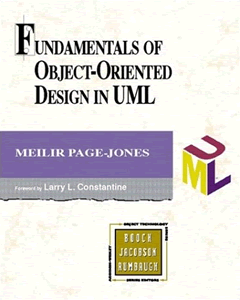Fundamentals Of Object-Oriented Design In UML By Meilir Page-Jones
Last week, I finally finished reading the Fundamentals Of Object-Oriented Design In UML By Meilir Page-Jones. Clark Valberg suggested this book to me almost a year ago when I was struggling with my Exercise List sample app for object oriented programming in ColdFusion. He said it totally changed the way he thought about object oriented programming. You may have also heard Hal Helms recommend this book; in fact, I believe I even heard that he [Helms] re-reads this book like once a year.
| |
|
|
||
| |
 |
|
||
| |
|
|
I don't want you to think that it's taken me a year to read it - it's been a very on-again, off-again relationship. The actual reading took me just a few weeks. To be honest, though, I didn't read all the chapters. The middle section is all about Universal Modeling Language (UML) diagrams, and frankly, that didn't interest me all that much. Right now, I'm fairly satisfied with boxes and lines and some text. Until what's in my head becomes more accurate, I am not sure it matters how accurately I draw it on paper.
The rest of the book is jam packed with great object oriented principles - far more than I could ever absorb in one or two readings. After finishing this book, I can see why a man as brilliant as Hal Helms would reread it a number of times; there's just so much content here.
I feel like my first read through of this book was just to familiarize me with the high level concepts and the vocabulary. There are many terms in this book that I have never heard before in the computer science world. For example:
Connascence - Between software elements A and B, the property by which there is at least one change to A that would necessitate a change to B in order to preserve overall correctness.
Contranascence - Between software elements A and B, a form of connascence in which there is some property of A that must be held different for the corresponding property of B.
Extrinsic - B is extrinsic of A if A can be defined with no notion of B.
None of these concepts are difficult to understand on their own; but, after learning so many new concepts in a row, it becomes hard to follow conversations about them. I think what I need to do is study the Glossary a bit, then go back through the book chapter by chapter. At the end of each chapter, I should probably write a little summary about what it meant, but in my own words. I had to do this in 4th grade English class... and it done worked out pretty good for me then. That in and of itself might make a kind of interesting blog series, not unlike Sammy Larbi's series on Chad Fowler's, "My Job Went to India."
While I cannot yet grasp all the value that this book has to offer, I can definitely see that it is and will be a book that I recommend to people. More to come....

Reader Comments
It is indeed an amazing book. Like Hal, I reread it on a regular basis (along with The Pragmatic Programmer).
@Brian,
Yeah, I'll definitely have to put that into regular rotation.
One of my favorite in OO A/D is Craig Larman "Applying UML and Patterns". I have to check out this one to..
Reading it again, years later, it really made me think about object inheritance and coupling / encapsulation:
www.bennadel.com/blog/2481-A-Sub-Class-Should-Not-Access-Private-Variables-In-Its-Super-Class.htm
Still too much of the book is a bit over my head, but taking away a bit more each time.
That said, I'm currently reading a book, "Object Thinking," by David West. The deep philosophical nature and object anthropomorphization found in Object Thinking makes "Fundamentals" feel like a walk in the park :D